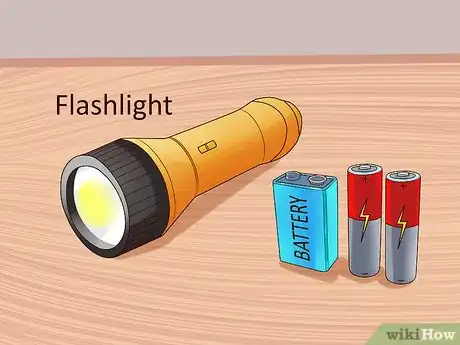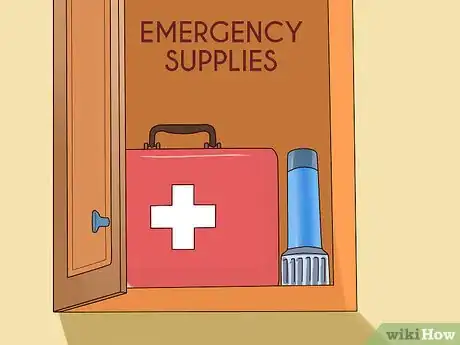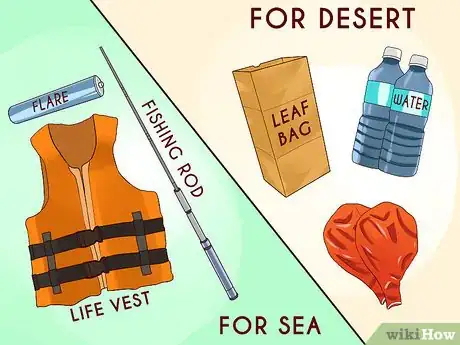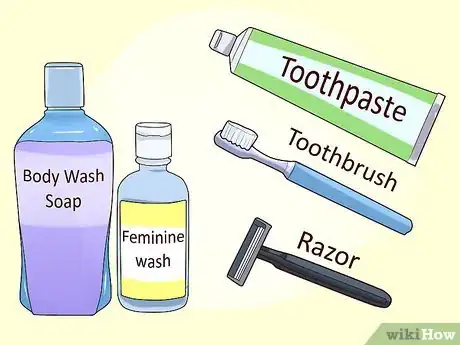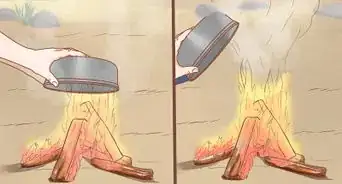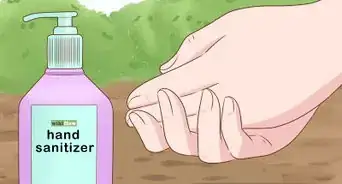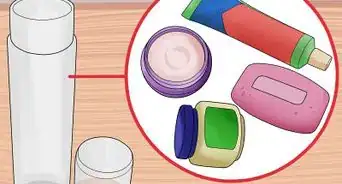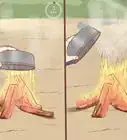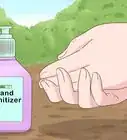This article was co-authored by wikiHow Staff. Our trained team of editors and researchers validate articles for accuracy and comprehensiveness. wikiHow's Content Management Team carefully monitors the work from our editorial staff to ensure that each article is backed by trusted research and meets our high quality standards.
There are 19 references cited in this article, which can be found at the bottom of the page.
wikiHow marks an article as reader-approved once it receives enough positive feedback. In this case, 83% of readers who voted found the article helpful, earning it our reader-approved status.
This article has been viewed 257,202 times.
Learn more...
You always want to feel secure and prepared in case the worst happens. Having a proper survival kit stored and ready for an emergency is a critical part of keeping you and your family safe during the event of a crisis. When making your kit, you want to make sure that you pack the essentials and cater the equipment to the situation that's most likely to happen. If you act methodically and thoroughly, you can make a survival kit that will increase your odds of staying safe during an emergency.
Steps
Building a Disaster Supply Kit for the House
-
1Organize and store a first-aid kit. A first-aid kit will prevent small injuries from becoming infected and leading to major medical complications. Things that should go into your first-aid kit include iodine, gauze pads, medical tape, alcohol wipes, antibiotic ointment, aspirin, scissors, and a scalpel.[1]
- Optional items in your first-aid kit should include things like vitamins, sunblock, and bug repellent.
- Remember to pack all medicines needed, including inhalers.
-
2Stock up on water. Consider the number of people that you have in your household and determine how much water you'd need for two weeks. You should be able to pack at least one gallon per person, so if you were alone, that would be 14 gallons of water total. If you have more people in your family, you'll need to pack more water to keep everyone hydrated.[2]Advertisement
-
3Store enough non-perishable food. Bring at least three days of non-perishable food. This includes things like canned foods, salt-free crackers, and whole grain cereals. Foods to bring in a survival situation include rice, beans, peanut butter, canned meat, and lard.[3] Choose things that don't require refrigeration and that don't have long preparation times.[4]
- If you are stranded in the wilderness, you may be able to scavenge food from local plants, bugs, animals, or fish.
- Purchase a manual can opener so that you can use in any situation.[5]
- If you forget to bring a can opener, you can use a survival knife as an alternative.
-
4Stock up on flashlights and extra batteries. A flashlight can be used to illuminate areas when it gets dark and is a versatile survival tool. Flashlights are critical if your car breaks down on the side of the road or if you're stuck outside at night with no light. Purchase lithium batteries over alkaline because they provide more power and have a longer shelf-life.
- You can also use a flashlight as a blunt self-defence weapon.
- Popular survival flashlights include Elzetta Bravo, Olight M23 Javelot, and Eagletac GX30A3D.
-
5Keep a wrench or pliers readily available to turn off utilities. During a natural disaster, you may have to turn off your utilities like water, natural gas, and electricity. Cracked lines in water pipes could pollute your water, while natural gas leaks could lead to an explosion. Keep pliers or a wrench packed in your emergency supply kit in case this happens.[6]
-
6Store your emergency items together. Let everyone in the household know where the emergency kit is. In the case of an emergency, you may be required to pick up and leave quickly so it's better if all of your emergency items are organized together. Good places to store your emergency kit include an attic, the basement, a closet, or shed.
Making a Survival Kit for the Wilderness
-
1Consider the climate and terrain. Before you start to pack your survival kit, you'll have to determine the climate and conditions of the place that you'll be. For instance, a desert climate will require different equipment than if you were stuck in a forest or at sea. Cater your survival kit to the climate and environment.
-
2Purchase a survival knife. A good knife can be used in a multitude of ways when you're in the wilderness. A knife can help you build shelter, start a fire, hunt, cut food, clear paths, and cut twigs and string. Find a knife with a good balance of durability and cutting power, with a Rockwell Hardness between 54 to 58. You'll want to find a knife that can both pierce and cut things.[9]
- A fixed blade knife is typically more durable than a folding knife under pressure.
-
3Bring sufficient water or purchase a water filter. If you are in an area that has fresh streams and lakes to drink from, then you can buy a portable water filter. There are portable survival straws that will filter viruses, microorganisms, bacteria, chlorine, and heavy metals like lead and mercury. If you are in a more arid environment or have limited access to freshwater sources, make sure to pack as much freshwater as possible.[10]
- Popular water filter brands include NDur Survival Straw, Sawyer Mini Water Filtration System, and the LifeStraw Survival Water Filter.[11]
-
4Carry a fire starter. When you're stranded in the wilderness, there's a good chance that you'll have to make a fire at some point. Fires can help you cook food and stay warm when it gets cold. There are multiple ways to do this including matches, a lighter, or a flint and scraper and each of these fire starting methods have their advantages and disadvantages.[12]
- Store multiple matches among your gear in case you lose one batch of matches.
- Get refillable butane lighters.
- A flint and scraper will make sparks for a fire when wet.
- Popular fire starter brands include Exotac NanoStriker XL, Coleman Magnesium Fire Starter, and UCO Titan Stormproof Matches.[13]
-
5Carry a compass or GPS device. A GPS device can help guide you if you get lost in the wilderness but usually requires battery power and a signal. GPS can also malfunction. For this reason, you should always have a backup.[14] When you can't use GPS, you can utilize a map in conjunction with a compass to find safety.
- Popular compasses include the Phosphorescent Lensatic Compass, the Suunto A-10 Field Compass, and the Cammenga 3H Tritium Military Compass.[15]
-
6Pack the supplies for a shelter. If you have to endure a night in the wilderness, you must build a makeshift shelter to stay warm or cool and protected from the elements. Items like tarps, ponchos, plastic sheets, or trash bags can be pinned to trees and act as a shelter. You can also buy tarps specifically created for survival at many outdoor shops.[16]
Packing Supplies For an Emergency or Evacuation
-
1Pack a hand-crank radio. An AM/FM hand crank radio will allow you to tune into special emergency notifications via NOAA alerts. To make sure that your radio can tune into those frequencies, check for the "Public Alert" and "NOAA NWR All Hazards" label on the packaging of your radio. A hand-crank will ensure that even if you run out of batteries, you'll still be able to tune into critical alerts and announcements.[17]
- NOAA AM alerts are available in all 50 states of the U.S. on frequencies 162.400, 162.425, 162.450, 162.475, 162.500, 162.525, and 162.550.[18]
- Check online to see the emergency frequency if you live outside of the U.S.
- Radios typically cost anywhere from $25 to USD 50.
-
2Bring cell phones and extra cell phone chargers. Cell phones are great devices to use to communicate during an evacuation or emergency. Make sure to bring extra batteries or boosters for your cell phones to increase the longevity of their use. Minimize use of your cell phone when you don't have access to a power source, and use it only to communicate important information to family and friends.[19]
- You can also purchase a solar-powered or hand crank charger that will help keel electronic devices charged during an emergency.
-
3Bring a map. During an emergency, your GPS or phone may not be available. For this reason, it's important to keep a road map so that you know how to get to your evacuation site. Purchase a traditional paper road map from a gas station or you can print one out online and keep it in emergency storage in case of an emergency.[20]
-
4Store personal hygiene products. If you need to leave in a rush and your area is devastated by a natural disaster, it may be difficult to find common hygiene products like toothpaste, toothbrushes, soap, razors, and feminine hygiene products. Make sure to put extra supplies in a zip lock bag and store it in your emergency supplies.[21]
-
5Bring extra sets of clothing. You may not have access to your wardrobe for a long time after the emergency, so it's important to remember to pack extra sets of clothes. If you live in a place that experiences cold temperatures, bring the appropriate attire, such as, jackets, pants, shirts, and sweaters.[22]
Community Q&A
-
QuestionWhat about a compass and a map? Also, why do I need to bring cotton balls and safety pins?
 Community AnswerIndeed, you should bring a map and compass too. The safety pins are for your clothes if they should rip, allowing you to hold the clothing together. The cotton balls are for a fire starter and for cleaning dirt off items if needed.
Community AnswerIndeed, you should bring a map and compass too. The safety pins are for your clothes if they should rip, allowing you to hold the clothing together. The cotton balls are for a fire starter and for cleaning dirt off items if needed. -
QuestionWhy do I need to bring a small notebook?
 Community AnswerThe notebook can be used for anything that you need to take note of, like an emergency plan or escape route. The paper can also be used as a fire starter if necessary.
Community AnswerThe notebook can be used for anything that you need to take note of, like an emergency plan or escape route. The paper can also be used as a fire starter if necessary. -
QuestionWhat about batteries, and what size?
 Community AnswerBatteries are only really necessary if you have electronic devices that are vital to your survival. Flashlights or something like handheld radios/walkie talkie type devices or NOAA weather radios are good devices to have. If you wish to include these in a kit (flashlight strongly recommended), check what size batteries are required for your devices and include spares in your kit. Also, applying both terminals of a 9V battery onto steel wool creates a short circuit, and along with that a fire/embers. This is one of many ways to make fire.
Community AnswerBatteries are only really necessary if you have electronic devices that are vital to your survival. Flashlights or something like handheld radios/walkie talkie type devices or NOAA weather radios are good devices to have. If you wish to include these in a kit (flashlight strongly recommended), check what size batteries are required for your devices and include spares in your kit. Also, applying both terminals of a 9V battery onto steel wool creates a short circuit, and along with that a fire/embers. This is one of many ways to make fire.
References
- ↑ http://www.skilledsurvival.com/build-survival-medical-kit-scratch/
- ↑ http://www.redcross.org/get-help/prepare-for-emergencies/be-red-cross-ready/get-a-kit
- ↑ http://www.activistpost.com/2012/10/10-best-survival-foods-at-your-local.html
- ↑ https://www.ready.gov/food
- ↑ https://www.ready.gov/kit
- ↑ https://www.ready.gov/safety-skills
- ↑ http://www.desertusa.com/desert-activity/survival-kit.html
- ↑ http://www.airseasafety.net/rescue-accessories.html
- ↑ http://www.wildernesstoday.com/best-survival-knife/
- ↑ http://www.ammoland.com/2014/07/survival-water-filters/#axzz4Yhp5UdHB
- ↑ http://www.ammoland.com/2014/07/survival-water-filters/#axzz4Yhp5UdHB
- ↑ http://survivalcache.com/survival-fire-starters/
- ↑ http://gearpatrol.com/2015/09/03/best-fire-starters/
- ↑ http://survivalcache.com/death-by-gps-survival-electronics-backup/
- ↑ http://www.reloaderaddict.com/best-survival-compass-review/
- ↑ http://www.practicalsurvivor.com/survivalkitbasics
- ↑ http://lifehacker.com/how-to-choose-a-reliable-emergency-radio-and-some-good-1640325400
- ↑ https://www.weather.gov/nwr/
- ↑ http://www.cnn.com/2011/09/02/tech/mobile/cell-phone-emergency/
- ↑ http://www.redcross.org/get-help/prepare-for-emergencies/be-red-cross-ready/get-a-kit
- ↑ http://www.livingrational.com/survival-kits/
- ↑ https://www.ready.gov/kit
About This Article
To make a survival kit for the wilderness, purchase a good knife that can be used to help build shelter, start a fire, hunt, cut food, clear paths, and cut string. Additionally, buy a portable water filter if you’ll be in areas with fresh streams and lakes to drink from. Alternatively, if you’ll be in more arid areas, then pack as much fresh water as possible. You'll want to have a fire starter, such as matches, refillable butane lighters, or a flint and scraper, too. Also, bring a compass or GPS device in case you get lost. To learn how to make a survival kit for your house, keep reading!



